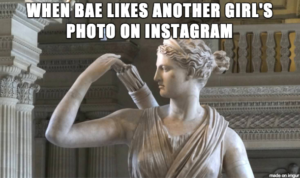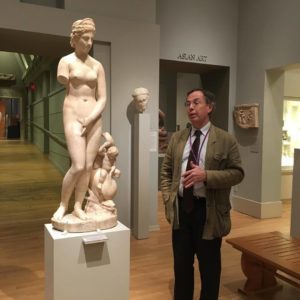Vicky Alvear Shecter's Blog, page 3
September 10, 2019
Happy Book Birthday, Queens!
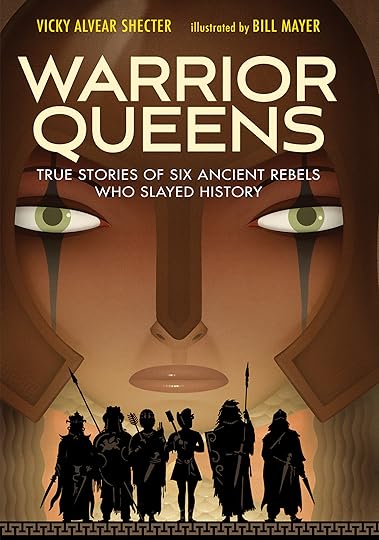 Today is the official release day for Warrior Queens: True Stories of Six Ancient Rebels Who Slayed History.
Today is the official release day for Warrior Queens: True Stories of Six Ancient Rebels Who Slayed History.
I am still amazed by the beautiful cover and illustrations by outstanding artist, Bill Mayer. Seriously, check out his site because his work is consistently stunning.
The joy of working on a book like Warrior Queens was not just diving deep into the stories of queens I already knew something about (Hatshepsut, Artemisia, Boudicca, Zenobia), but learning more about kick-butt queens that I’d never heard of, such as Amanirenas of Nubia and the Trung Sisters of ancient Vietnam. There are many more amazing fighting queens in the world, of course, but these six captured my heart.
You can meet them below or ask your local library to get a copy of the book for you or the young history nerd in your life:
Your Local Independent Bookstore
The post Happy Book Birthday, Queens! appeared first on Vicky Alvear Shecter.
August 26, 2019
When Kendare Blake Blurbs Your Book!
The author of the dark and delicious, #1 New York Times bestselling Three Dark Crowns series was kind enough to blurb my upcoming nonfiction book, Warrior Queens.
I still can’t get over the awesomeness! Here’s what she said:
 Warrior Queens comes out September 10!
Warrior Queens comes out September 10!“Vicky Alvear Shecter’s Warrior Queens is a wonderful profile of irrepressible women, some of whom history has overlooked. The snappy narrative style and perfect use of puns makes it clear that the author not only knows, but admires these queens. It’s a great reminder that even in ancient times, women (and often teen women!) knew how to push back.”
I love that–especially the part about how young women have been pushing back and owning their power since time immemorial.
Thank you, Kendare!
I first met Kendare years ago at a book festival soon after her debut, Anna Dressed in Blood released. That book is still one of my favorites, as are all of the kick-a** queens in the Dark Crown books. The fourth and last book in that series–Five Dark Fates–by the way, comes out September 3. Check them out! Enjoy the stories of Kendare’s dangerous queens and then share Warrior Queens with younger readers who love learning about real strong women in history!
Enjoy the stories of Kendare’s dangerous queens and then share Warrior Queens with younger readers who love learning about real strong women in history!
The post When Kendare Blake Blurbs Your Book! appeared first on Vicky Alvear Shecter.
April 2, 2019
Check Out My New Book Coming this Fall!
Publisher’s Weekly listed my latest nonfiction–Warrior Queens–in its Fall 2019 Children’s Sneak Preview issue, so it seemed the right time to show you the cover.
TA-DA!
Warrior Queens, true stories of six ancient queens who took up arms against invaders and enemies, has been a labor of love long in the making. Thank you Boyds Mills Press for believing in it!
The brilliant Bill Mayer illustrated the book and I have been just BLOWN AWAY by his work. Check out one of the interior spreads!
Look at how fearlessly Queen Amanirenas of Nubia pushes back against Roman invaders (and during the time of Augustus too!).
Seriously, I think Amanirenas might be my favorite (shhhh, don’t tell the others), if for no other reason than few have ever heard of her, but mostly because she tangled with the most powerful emperor on the planet and won. (You’ll have to read the book to find out how.) She was powerful and amazing, as were all the other ancient queens featured in the book, including Hatshepsut, Artemisia, The Trung Sisters, Boudicca, and Zenobia.
This is an upper middle-grade, young YA (i.e., best for middle-school) book.
Support the study of fascinating women–pre-order Warrior Queens by yours truly at your favorite independent bookstore or through Amazon.
Go and slay my warrior queens!
The post Check Out My New Book Coming this Fall! appeared first on Vicky Alvear Shecter.
November 23, 2018
It Wasn’t All Wine and Song, Ya Know…
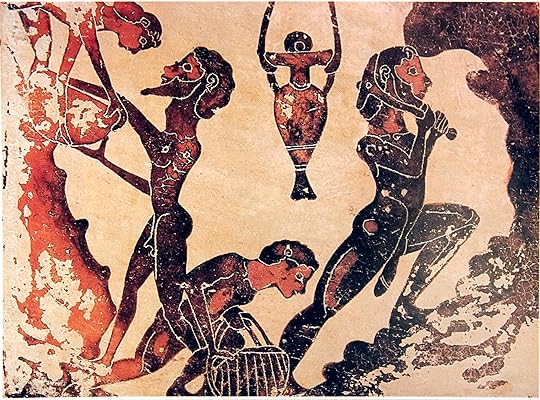 Greek slaves working in the mines of Laurium.
Greek slaves working in the mines of Laurium.I love this article about teaching ancient slavery in the South by professor Sam Flores at the College of Charleston. Living in Georgia, I always bring up slavery in my tours at the Carlos Museum and when I make presentations at schools. Why? Because I think it’s important to discuss two points:
1) That most ancient slaves were not from Africa. Especially in the American South, the default face of slavery is black. There’s a psychological price, I think, for children to only ever see African faces as slaves in history. The Atlantic slave trade–especially the horrors of the American chattel-slavery system–took place more than 1,500 years after the classical world. The face of slavery in the ancient world was not African but largely Greek and Roman (i.e., European). Slaves were most often taken from defeated people in war and for the most part, the Greeks and Romans fought their neighbors (until Rome began to take over the world, but even then, the faces of slavery were still mostly European–from Italy, Greece, France, Germany, Bulgaria, Spain, and Britain).
North African, Egyptian, and middle eastern slaves, were added to the slavery pool as Rome expanded, of course, but still, Rome never succeeded in going deeper into Africa than Egypt. In my next kid’s book, I have a chapter on a kick-ass Nubian queen named Amanirenas, who personally led her armies to repel Roman forces venturing into her territories five different times, until finally, Augustus made an agreement with her to never again try invade her kingdom (Source: Strabo, 54). During most of the ancient world, Nubia–also called Kush or Meroe–was strong, powerful, wealthy, and independent. Nubia essentially controlled the ancient world’s supply of gold, iron, spices, and African wildlife.
I very much want all Southern students who are normally only exposed to one snapshot of African history to see the larger heritage of ancient African societies.
2. The other point about ancient slavery that I want kids to understand is that owning another human–a practice rightfully considered atrocious, immoral, and inhumane in our time–was considered “normal” and “inevitable” to the ancients. In other words, the ancient Greeks and Romans didn’t think that there was anything fundamentally or morally wrong with slavery AS A PRACTICE. Therefore, there were no abolition movements. Even when slaves rebelled, they weren’t trying to bring down the institution of slavery, of owning other humans–they just (!) wanted their freedom and to go home again. Indeed, Spartacus’s rebellion wasn’t about ending slavery, but began as a quest for him to return to Thrace (southeastern Bulgaria).
I like to make this point because it allows us to explore the concept that IDEAS evolve too. There was a time when almost all kings in the ancient world claimed divinity (including the Caesars) and this was considered normal. Today we scoff at that idea. There was also a time in the ancient world when slavery was considered morally acceptable and inevitable. Today, most people cannot conceive of the practice as anything beyond abhorrent and morally reprehensible.
What, I like to ask kids, do we today accept as completely “normal” and “inevitable” that a thousand years from now may leave observes scratching their heads in dismay? For me, it’s a hopeful discussion, as it reminds us that despite mankind’s universal fear of change, our ideas can evolve for the better.
Dr. Flores sums up the importance of engaging with the ugly side of the classical world up perfectly: “The reality of slavery has been one of unimaginable suffering and inhumanity for thousands of years. Its roots in classical civilization and culture serve as a reminder that we don’t study the classics solely to celebrate the achievements of antiquity, but also to understand the ways in which the culture and institutions of the ancient Mediterranean have been used and abused as exemplars to abhorrently long-lasting effect.” You can read his article here.
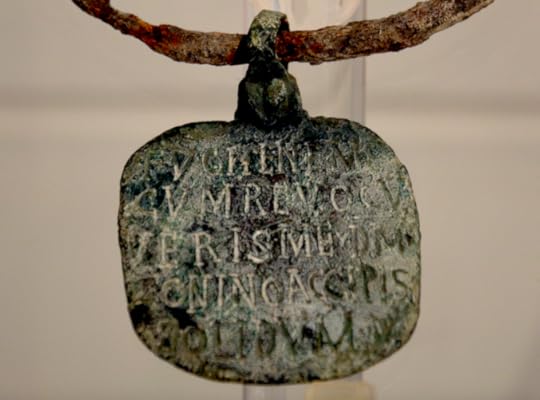 Slave collar, 4th-6th century CE, from the article in the Society for Classical Studies, November 23, 2018.
Slave collar, 4th-6th century CE, from the article in the Society for Classical Studies, November 23, 2018.The post It Wasn’t All Wine and Song, Ya Know… appeared first on Vicky Alvear Shecter.
September 13, 2018
The Myth Behind This Extraordinary Helmet
They call it “Mark Antony’s Galea,” the legendary helmet created by Cleopatra’s Egyptian craftsmen and smiths for her Roman consort, Mark Antony. Featuring Egyptian iconography, this extraordinary helmet is beyond gorgeous. And, if you can believe it, was created completely by a 3D printer!
That’s right. It’s a creation by Custom Prototypes in Toronto and (unsurprisingly) won top honors at the International 3D Printing Competition last year. According to the creators, “We used metal printing technology known as DMLS (Direct Metal Laser Sintering). All the gems are 3D printed in plastic using SLA (stereolithography) technology.”
Metal 3D printing! And how amazing and gorgeous is the result? Nobody has created anything like this before or since. I learned about it when the company contacted me asking me to help them write a legend to go with the helmet. As you can imagine, I was all over it!
Introducing:
The Legend of Antony’s Egypto-Roman Galea
It began with a vision. In 34 BCE, the queen of Egypt beseeched Isis to protect her consort, the Roman general, Mark Antony, in battle. Swathed in golden robes and wearing the blue crown of war, Cleopatra VII led a massive bull to the goddess’s altar for sacrifice.
When the priest slit the beast’s throat, the gods granted Cleopatra a vision: within the blood she saw Antony fighting with the fury of Hercules. As he cut down a Parthian warrior, another sword—curved and foreign—came into view, arcing toward the general’s exposed neck.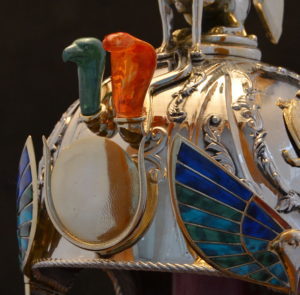
“No,” the queen cried and the vision froze. “Save him, save Egypt,” Cleopatra pleaded.
“To save one is to save the other,” echoed the mysterious voice of the goddess. “Will you expose your own neck to save both?”
“I will,” the queen promised.
In that moment, the vision changed. Horus, in his falcon form, spread his wings over the sides of the general’s helmet, blocking the deathblow. A flash of light, as piercing as staring directly into the sun, blinded the enemy. Many would later swear they heard the roar of a lion, the hissing of snakes and the sound of a great hoofed beast tramping through the fields of war.
When the vision evaporated and the sacrificial bull breathed its last, Cleopatra knew two things: Antony would emerge victorious in Parthia, and she would honor the gods by creating a new helmet for him. The goddess had made clear that Egypt’s fate was inextricably tied to Antony’s life.
The queen put Egypt’s best metalworkers and jewelers to the task. Her artisans forged the base out of polished steel then covered it in gold. They hung Horus’s falcon wings—shining with lapis lazuli, garnet, and turquoise—over each cheek plate, just as he’d appeared in Cleopatra’s vision. Isis’s own symbol—the sun disk cradled in Hathor’s horns—covered the brow. Amun in the form of a great horned ram protected the back. Winged lions adorned the sides and a mighty sphinx, bearing the queen’s own face, balanced before the Roman horsehair crest of brilliant red.
Finally, Egypt’s symbols of royalty—a malachite vulture and a carnelian cobra—reared majestically over the shining sun disc. The artisans even cushioned the helmet’s insides with Nile crocodile skin.
When Antony returned to Alexandria, the queen presented him with the magnificent helmet before his victory parade through the city. It was said that later Antony admitted to feeling a strange power lift him up as he slid the ornate helmet over his head.
At the sight of the Roman general protected by Egypt’s most powerful gods, Egyptians roared in approval. The helmet became the symbol of a future where Egypt and Rome—the east and the west—united to create a more stable empire.
At the end of the parade, Antony bestowed Cyprus, Libya and Syria to the queen. To his three children with Cleopatra—two sons and one daughter—he gave territories in Armenia, Media, Phoenicia, and Syria.
The Egyptians were overjoyed with the expansion of Egypt’s territories. But the Romans were horrified.
Antony’s rival, Octavian, decried the general’s “betrayal” of Roman ways: How dare he hold a Roman Triumph on foreign land? How dare he give Roman lands to a foreign queen and their illegitimate brood? How dare he wear an Egyptian helmet elevating the queen’s image above the Roman symbol of war? Surely, that was proof she had unmanned him!
 As word spread of his so-called disloyalty, Antony put aside the helmet. Soon after, Octavian declared war on Cleopatra.
As word spread of his so-called disloyalty, Antony put aside the helmet. Soon after, Octavian declared war on Cleopatra.
Three years after the creation of the helmet, Antony and Cleopatra’s navy faced off with Octavian at Actium in Greece. But Octavian’s continuing campaign against Antony for “choosing the Egyptian queen over Roman duty” took its toll. Many of the general’s allies and officers turned against him.
On the day of the battle, Cleopatra urged Antony to wear the helmet. He refused. He’d heard the whispers of his own men questioning his loyalties.
According to legend, that was the moment the Egyptian gods abandoned Antony.
During the battle of Actium, the queen spotted Octavian’s general—Agrippa—encircling their navy. Unable to alert Antony in the chaos, she gave the order to hoist the sails and made for the opening before the trap closed. Antony quickly followed.
Octavian claimed that the queen had abandoned Antony and that he had, in turn, deserted “those who were fighting and dying in his cause.” The propaganda worked. His captured navy and all of his land legions defected to Octavian.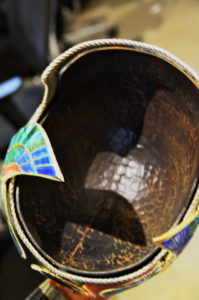
Antony had nothing left but his remaining small force in Alexandria. And the queen.
In 30 BCE, as Octavian’s army stormed Alexandria, Cleopatra at last convinced Antony to wear the helmet forged from her vision. But it was too little, too late. When he gave the order to attack, his warriors refused. To a man, they defected to Octavian.
In a fury, Antony retreated to the palace, bellowing with rage at the betrayal of his most loyal men. Later, Octavian would claim that it had been the queen who had betrayed him, so that Antony’s Roman deserters could save face.
But the queen had not abandoned him, even when, weeks before, Octavian secretly sent her a promise to reinstate her if she handed Antony over to him.
She never did, of course.
But the final insult and loss was too much for Antony. He fell on his sword. As he lay dying, he begged to be taken to Cleopatra. Still gripping the now blood-soaked helmet she had made for him four years earlier, he died in her arms.
Cleopatra hid the helmet from her captors, convinced that Octavian would desecrate it, steal its precious jewels and melt the gold down for his own use.
After weeks of house arrest, Cleopatra begged to visit Antony’s tomb. She smuggled the helmet to the Priests of Anubis and instructed them to bury it with his body.
Then, with her two ladies, Cleopatra returned to her mausoleum where she awaited a delivery of figs. Inside the fruit basket slithered a deadly asp, the symbol of Egyptian royalty and eternal life.
She sent a final message to her conqueror: bury me with Antony. And, in keeping with her promise to the goddess, Cleopatra exposed her neck to the venomous cobra.
The location of the double tomb of Cleopatra and Antony has been lost to the fog of history. The legend of Antony’s helmet, however, never died.
For more than two thousands years, it was whispered that if found and worn by one deemed worthy, the old Egyptian gods would imbue the helmet’s wearer with the power to unite the east and west in peaceful cooperation as Cleopatra and Antony had once envisioned. Until then, strife and distrust would continue to reign.
The recreation of this magnificent helmet is perhaps the first sign that the tomb of the last queen of Egypt and her Roman consort will soon be discovered. And the helmet’s legendary power finally resurrected.
#End#
Check out more of the company’s extraordinary work here. For more information on the creators of this helmet, contact Custom Prototypes at T: 416.955.0857 • F: 416.955.0858 • C: 416.706.9183.
Because if these amazingly talented craftsmen can create something this beautiful as a creative exercise, imagine what they can do for you!
The post The Myth Behind This Extraordinary Helmet appeared first on Vicky Alvear Shecter.
September 6, 2018
Did You Know Ancient Egyptians Believed Cats Bear Sacred Symbols on Their Heads?
 Not all of them, of course. But enough of them that it likely reinforced the ancient Egyptian belief that cats were conduits of the divine. It’s right there, smack in the middle of their foreheads: the symbol for Ra, or Khepri-in-the-Morning, the sun god in the form of a scarab beetle.
Not all of them, of course. But enough of them that it likely reinforced the ancient Egyptian belief that cats were conduits of the divine. It’s right there, smack in the middle of their foreheads: the symbol for Ra, or Khepri-in-the-Morning, the sun god in the form of a scarab beetle.
Do you see it? It’s not a line for line “stamp” of a scarab beetle, but it is clear enough to evoke the most powerful symbol of protection and good fortune for the ancient Egyptians. And that in itself was divine. Here’s a real scarab beetle and how the Egyptians evoked it in their sacred art:
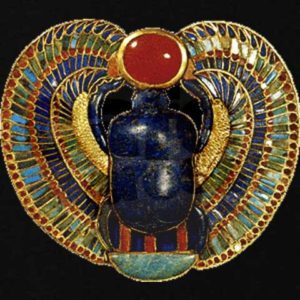
These “stamps of the divine” on cat’s foreheads appear quite distinctly in Abyssinian cats (in the picture above and directly below), but you can also see the evocation of them on striped or tabby cats too:

This little nugget of insight came out of the trainings we received for the Divine Felines exhibit currently running through November 10, 2018, at the Carlos Museum at Emory University. If you haven’t seen this fabulous show and you’re in Atlanta, contact me! I will be happy to give you a personal tour.
Unfortunately, I can’t remember if it was the show’s organizer, Dr. Yekaterina Barbash of the Brooklyn Museum, or Dr. Melinda Hartwig, the Carlos museum’s curator of Ancient Egyptian, Nubian and Near Eastern Art, who shared this information with us docents during trainings. But, it has stuck with me.
And I’m using it as an excuse to talk about this:
Yes, I purchased this little guy at the museum bookstore. After giving a tour of the Egyptian galleries at the Museum yesterday, I told myself that I would peek into the bookshop. Just for a quick look. I would be strong and not buy anything. This time.
LIAR!
Turns out I have absolutely no self-control whenever I step into this fabulous bookstore. Why? Because manager Mark Burell consistently fills the shop with some of the most fascinating and unique books related to not just our galleries, but to art, mythology, history, philosophy, religion and even quirky yet somehow always literary fiction. In the midst of so much intellectual largesse, my promise to not spend money went up in flames the moment I saw…this stuffed cat (I am not proud, okay?)
But seriously, I was done for. Even Mark, bless his heart, 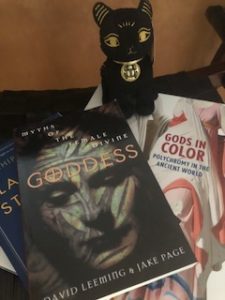 chuckled at my inability to put that darn thing down!
chuckled at my inability to put that darn thing down!
However, when I tried to distract from my childlike clutching of said stuffed cat to my chest, I mentioned the scarab symbols on cats’ heads as a curiosity. Mark didn’t look like he quite believed me but I told him it was true and that I would post about it on my blog.
“Ah,” he said. “That’s a good way to make this purchase somehow business related.”
“YES,” I said. “Exactly.” And, as usual, I rounded out my purchase with more fascinating books:
I’m especially excited about Gods in Color, an exploration of the latest research on the ways in which the ancient Greeks and Romans painted their statues. It’s a sumptuous book!
Meanwhile, I had to put back at least five other books–including a gorgeous graphic novel named Monstress–I wanted because enough was enough (said my inner pocket book critic).
I can’t guarantee that I will be able to walk out of the store without them the next time I stop by. Although I always promise myself I will.
Divine Felines runs through November 10th at the Carlos Museum. Have you seen it yet? If the answer is, “No,” my response is, “Why not?” Also, hisssssssss.
The post Did You Know Ancient Egyptians Believed Cats Bear Sacred Symbols on Their Heads? appeared first on Vicky Alvear Shecter.
February 13, 2018
Making Memes with Teens at W. VA. JCL Conference
Thanks to Dr. Nicoletta Sella, I had the pleasure of speaking at the West Virginia Junior Classical League annual conference recently. Every time I attend a JCL event and hear teens talking about ancient Rome and parading about in togas I think, “*sob* These are my people!”
The wild and crazy world of ancient Rome and mythology never ceases to fascinate me. I shared some surprising and hopefully intriguing tidbits in a presentation I called:
From the gods of toilets and sewers to snacking on barbecued giraffe (or elephant) at gladiator games, we discussed some of the strangest and funniest things I’ve learned about living in the ancient world. To cap off my talk, I held a meme contest (winners determined by clapping). I showed them one that I had made, called “Extreme glow up.” The make-up wearing kids in the group got it (or at least they were polite enough to pretend they did).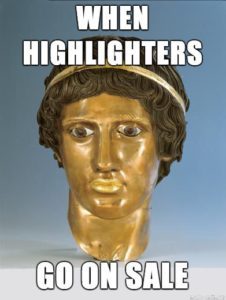
Sadly, I accidentally left the winning entries on the podium (along with my glasses), but I still remember my favorites ones:
The intense nature of ancient art certainly lends itself to meme-making! The whole event was a lot of fun. I’m incredibly grateful to JCL and its commitment to keeping the classical world alive and real for future generations.
For any Latin teachers that stumble across this post, invite me to speak to your students or at your conventions. We ancient history lovers need to stick together! And thanks again to Nicoletta and the West Virginia JCL!
The post Making Memes with Teens at W. VA. JCL Conference appeared first on Vicky Alvear Shecter.
December 5, 2017
The Women of the Odyssey Have Something To Say About Modern Sexual-Harassment
How they Help Us Explore the Disconnect Between A Man’s Self-perceived Goodness and the Actual Consequences of His Actions.
When internet porn was new, I had a boss who pressed a button so that photos of naked women and/or porn would flash on his large computer screen–which he swiveled my way–every time I walked in to his office. He once asked me to sew a button on his coat in exchange for reading my copy as a deadline loomed.
Every woman has stories like this. But here’s what I found really shocking: when I good-naturedly teased my boss about being mildly sexist, he was shocked and deeply offended. He was a wonderful and devoted father to his little girl, he exclaimed. He did not appreciate me saying such a thing.
I remember staring after him as he left the building, struck dumb by his complete and utter lack of self-awareness. He was a feminist, he believed, because…because…his little girl?
Enter Odysseus
This disconnect between what men do to and around women and how they perceive themselves as good, decent guys is really interesting to me.
Without realizing it, the H-Team explored that very dynamic all throughout A SEA OF SORROW: A NOVEL OF ODYSSEUS. We didn’t intend to, of course, but by giving voice to many of the women who are voiceless in the Odyssey, we naturally addressed women’s actual lived experiences as they contended with the fallout from his “heroic” escapades.
While Scott Oden’s powerful story about the Cyclops may seem like an exception, it isn’t. His battered Cyclops is filled with venomous rage over Odysseus’s invasion and physical attack. Men, he reminds us, are also victims of abuse and violence.
The Women in Odysseus’s Life
But it’s the women’s stories that really illustrate the disconnect is between a man’s self-perceived goodness and the actual consequences of his actions.
I had the privilege of writing from Penelope’s point of view. My outwardly gentle Penelope is inwardly pissed that she’s had to clean up the mess Odysseus left behind when he didn’t come straight home from Troy–including a devastated population grieving over the loss of all of Ithaca’s “best men.” Plus, she had to keep his people from starving and his economy from collapsing after he “lost” all of the Trojan gold. Odysseus, for his part, never focused on what her hardships might be, but only on how lovely and faithful she was.  Libbie Hawker’s Circe’s intelligence and proficiency with herbal arts gets her branded a witch and she is exiled. She and her women learn to hunt and farm to survive on their own. They even create a modest trading economy. But all that changes when Odysseus invades. In Libbie’s retelling, Circe does not “welcome” him into her bed at all but is forced to acquiesce as she and her women are both overpowered and outnumbered. Her relationship with Odysseus is darker and uglier–and therefore more multi-textured and fascinating. The scene when she confronts Odysseus about his actions is riveting.
Libbie Hawker’s Circe’s intelligence and proficiency with herbal arts gets her branded a witch and she is exiled. She and her women learn to hunt and farm to survive on their own. They even create a modest trading economy. But all that changes when Odysseus invades. In Libbie’s retelling, Circe does not “welcome” him into her bed at all but is forced to acquiesce as she and her women are both overpowered and outnumbered. Her relationship with Odysseus is darker and uglier–and therefore more multi-textured and fascinating. The scene when she confronts Odysseus about his actions is riveting.
Amalia Carosella’s haunting Sirens are the living embodiments of what happens to women when outside trauma is internalized as self-blame and toxic religious duty. Hers is a story of the consequences of generational abuse. And Odysseus’s mythic view of them as cannibalistic monsters results in even more tragic violence.
David Blixt’s Calypso has more power than the other women in Odysseus’s world. And yet she too has to manage the emotional fall-out of loving a secretive, self-centered man preoccupied with his many failures and losses. It is her magnanimity that finally releases Odysseus. David captures Calypso’s dignity, intelligence, and vulnerabilities in ways that are both fresh and unexpected and yet so very real.

 (When I think of his Calypso, I see the faces of strong women such as Huma Abedin (left) and Annette Roque (right)–Matt Lauer’s wife–as they struggle to maintain stoic dignity in the face of loving deeply flawed men.)
(When I think of his Calypso, I see the faces of strong women such as Huma Abedin (left) and Annette Roque (right)–Matt Lauer’s wife–as they struggle to maintain stoic dignity in the face of loving deeply flawed men.)
Could Odysseus Be Redeemed?
All of this insight into how Odysseus’s careless and sometimes violent actions affected others left Russell Whitfield with one heck of a challenge. How was he going to bring Odysseus back into the reader’s good graces in the last chapter?
He managed it, as always, with inimitable style. He made Odysseus likable again by making him funny, vulnerable and sadly aware of his shortcomings. So deftly does Russ manage this, that by the time we see Odysseus reshaping his failings and mistakes into a “story” of grandly heroic adventures, we find ourselves smiling a bit sadly along with him. We can’t help but soften toward him because it’s such a human thing to do, this recasting of our foibles in the best possible light.
him funny, vulnerable and sadly aware of his shortcomings. So deftly does Russ manage this, that by the time we see Odysseus reshaping his failings and mistakes into a “story” of grandly heroic adventures, we find ourselves smiling a bit sadly along with him. We can’t help but soften toward him because it’s such a human thing to do, this recasting of our foibles in the best possible light.
Our Own Reflections
It’s interesting to me that although we didn’t set out to do this, we mirrored what was happening in our culture by exploring the lived experiences of women and men (think Terry Crews) who are usually silenced in the face of abuse by otherwise popular, powerful, funny and/or “lovable” men.
 It’s funny too that classicist Emily Wilson released her translation of the Odyssey around the same time we released A Sea of Sorrow. NPR’s headline on her book is perfect: “Emily Wilson’s ‘Odyssey’ Scrapes The Barnacles Off Homer’s Hull.”
It’s funny too that classicist Emily Wilson released her translation of the Odyssey around the same time we released A Sea of Sorrow. NPR’s headline on her book is perfect: “Emily Wilson’s ‘Odyssey’ Scrapes The Barnacles Off Homer’s Hull.”
Yes. Yes it does.
It’s something the H-Team attempted to do as well. That the Odyssey can still reflect what is happening in modern culture is a reminder of why the classical epics continue to fascinate: They hold up a mirror to ourselves. Sometimes that reflection shows us in all our deluded glory. And sometimes it shows us as our true selves–deeply flawed and struggling to tell the truth, all while highlighting our best angles.
###
A Sea of Sorrow: A Novel of Odysseus is available from Amazon, Kobo, iBooks, Barnes and Noble and your favorite independent bookstore.
The post The Women of the Odyssey Have Something To Say About Modern Sexual-Harassment appeared first on Vicky Alvear Shecter.
October 17, 2017
A SEA OF SORROW is Out Today!
The H-Team announces a new collaborative release–the story of the Odyssey told from the point of view of the witches, monsters, lovers, and enemies Odysseus left behind during his ten year journey back to Ithaca from the battlefields of Troy.
I am so proud to have been a member of this team–A Sea of Sorrow: A Novel of Odysseus is an amazing book. With collaborative storytelling, all of the authors work closely together to create a unified story with themes and characters that interweave throughout each other’s chapters. It offers authors the opportunity to creatively “play” with storytelling techniques that we may not ordinarily have the opportunity to do. The end result is something bigger and better than any one of us could’ve created on our own.
The novel opens, as Homer’s epic does, with Odysseus’s wife Penelope and his son Telemachus. From there, Scott Oden tells the remarkable story of a Kyklops that is both stunningly real and fascinating. Libbie Hawker follows with a devastating story from the misunderstood yet unbowed Circe. Next follows Amalia Carosella’s haunting and heartbreaking Siren. David Blixt’s Calypso follows as a strong queen on a remote island, forced to manage the emotional storm that comes when a strange king from a foreign land washes up on her shores. Finally, Russell Whitfield wraps the novel up with an Odysseus that is as humbled as he is arrogant, a wily trickster well aware of the calamitous cost of his trickery. I think you will find every new take on this ancient story both fascinating, fresh, and yet amazingly consistent with the source material.
You can order the book from Amazon, Amazon UK, iBooks, Kobo, and Barnes and Noble. We hope you enjoy it!
The post A SEA OF SORROW is Out Today! appeared first on Vicky Alvear Shecter.
September 20, 2017
Really, Zeus? REALLY?
 My impression of how Hera reacted–on the inside–to Zeus’s “pillow talk.”
My impression of how Hera reacted–on the inside–to Zeus’s “pillow talk.”A little scene from The Iliad recently came to my attention and it totally cracked me up. Of course, I had to share it here.
So in Book 14, the war between the Greeks and the Trojans is in full swing. Hera wants to create an advantage for the Greeks but she doesn’t want her hubby Zeus to know her plans, so she comes up with a distraction. And it involves the bedroom.
She goes to Aphrodite and says, “Gurrrrlll, I’ve been married to that old goat forever, so I’mma need a little somethin’-somethin’ to put a lil’ spark in his lightning rod, you know what I mean?” (Okay, that’s not how she said, but the essence is about right.)
The Goddess of Love says, yeah you definitely need to get lucky, and spritzes Hera with her proprietary “Super Sexzy Love Goddess” spray. Hera gets all dolled up, dabs herself with ambrosia in all the right places and sets off determined to start an electrical storm.
The god of the sky takes one look at her and is all in. Never, he says to her, have I been soooo turned on by any goddess or mortal as I am with you in this very moment.
He should’ve stopped there. (Seriously, Zeus. STOP. THERE.) But the impulsive god continued:
Girl, not even when I was in love with Ixion’s wife,
or with Danae of the pretty ankles, or was in lust with Europa,
or queen Ceres, or was super hot for Semele, or Alcmena,
and was all twisted up over Leto, was I as
turned on as I am with you right now.
I imagine Hera pausing and blinking a couple of times as she takes in what he just said. In fact, I picture her reacting like this–again, on the inside.
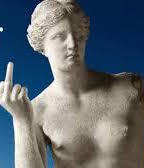 Let’s talk about your love-talk game, okay Zeus? ‘Cause it totally sucks.
Let’s talk about your love-talk game, okay Zeus? ‘Cause it totally sucks.Pro-tip gentlemen: do not–I repeat–do not compliment your wife by listing in chronological order all the women that you’ve shtupped on the side. Amazingly, Hera, Queen of the Temper Tantrums, says nothing. She’s got her eye on a bigger prize (helping the Greeks win), presumably, so she doesn’t explode into the kind of heifer-level rage she’s known for.
It’s a small scene but it’s so darned ridiculous! Really, Zeus? For a guy that can’t keep it in your loin cloth, you don’t know much about women, do you?
Jasper Gaunt, curator of the Greek and Roman galleries at the Carlos Museum at Emory University shared this little story during an intimate gallery talk with a handful of us docents recently. He pointed out that The Iliad was written for men, which was why it seemed reasonable that Zeus decides in that particular moment to brag about his conquests.
To his wife. Right before they get busy.
With the personalities involved, it’s a wonder that Zeus emerged from that encounter still in possession of his beloved lightning rod.
Thanks, Dr. Gaunt, for that wonderful reminder of why I love these crazy, timeless stories.
 ….do you have any idea how close you came to a royal ass-whooping ?
….do you have any idea how close you came to a royal ass-whooping ?
The post Really, Zeus? REALLY? appeared first on Vicky Alvear Shecter.





